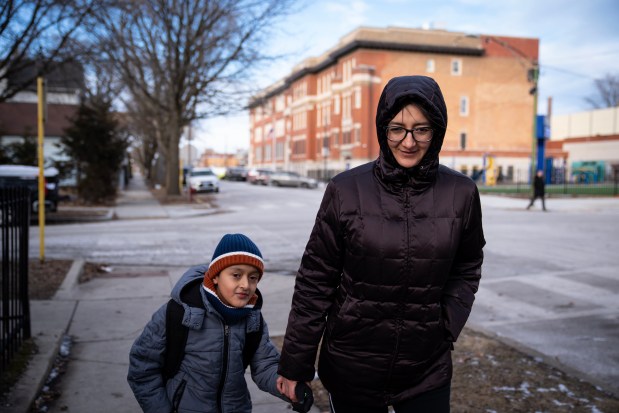When President Donald Trump took office and declared Chicago “ground zero” for the largest deportation operation in U.S. history, Alma Duran, 43, said her 10-year-old twins asked why their classes at an elementary school in Pilsen were deserted.
She told them some kids and parents were scared to come in for fear of getting detained and deported, and she explained the concept of the United States border to her children for the first time — that they were born in Chicago and had documents that some of their classmates might not have.
“And even then, my kids were like, ‘How is this possible? How can they be so afraid that they don’t even want to come to school? … Mommy, you always say going to school is good. How is it not good now for some friends?’” Duran remembered them asking her.
Trump’s hard-line immigration policy has taken a deep emotional toll on communities with large undocumented populations. And though attendance at Perez has slowly recovered in the months since Trump took office, fear and anxiety linger among parents, teachers and students at some Chicago public schools.
Data obtained by the Tribune through a Freedom of Information Act request shows that attendance rates fell at all schools across the district the week of Jan. 20, when the 47th president was sworn in. Over 50% of students attending the 10 schools that experienced the biggest attendance drops are Latino, according to enrollment data on the district’s website.
The names of the schools are being withheld at Chicago Public Schools’ request, out of concern for potential retaliation from the federal government.
While the district has taken steps to respond, parents and those working with students describe the effect of Trump’s immigration policy changes as insurmountable. It will likely have long-term effects, they say.
Students carry a heavy burden worrying about whether their parents will be swept up by U.S. Immigration and Customs Enforcement. Meanwhile, the counseling support they need to relieve their worry is spread thin, said Roy, a teacher at a South Side elementary school whose last name is not being used out of safety concerns for his students.
“We do have counselors, but they don’t speak Spanish,” he said. “That’s a resource that a lot of schools need now, especially with newcomers.”
CPS did not respond to a request for comment.
Emotional toll
Headlines about young U.S. citizens being deported by ICE have trickled into school settings, said Ana Espitia, a local school council member and crossing guard at an elementary school in Little Village, a neighborhood known for its strong Mexican American culture.
One migrant kindergartner has repeatedly come to school in tears, worried immigration officials might arrest his mom or dad, and that he wouldn’t see them again, Espitia said.
“A lot of times, kids use being sick as an excuse. They say they have a headache, or their stomach hurts,” Espitia said.
In some cases, students are bullying each other, saying they hope Trump will deport the other, according to Rocio Becerril, an immigration attorney who is an authorized vendor with CPS. She referenced an 11-year-old who died from suicide in Texas amid deportation rumors at school.
“This anti-immigrant sentiment is (likely) coming from their parents,” Becerril surmised. “But for that information to get to them is disheartening.”
Becerril leads Know Your Rights presentations to CPS parents and said that in recent weeks, fewer people have attended those sessions.
“People just curl up and pull away,” she said. “There’s so much information out there, and there’s so much misinformation.”
Inauguration Day
Parents recounted a significant psychological effect on their kids at a Back of the Yards elementary school where two U.S. Department of Homeland Security officials tried to enter on the Friday after Trump’s inauguration. The district sparked a panic when it falsely proclaimed ICE agents had tried to enter the building.
“They’re going to deport everyone who has our skin color,” an Ecuadorian migrant student, Aaron, said to his mom, Mary, at dismissal outside the school three days later, as she quieted his nerves.

Roy, the teacher at the South Side elementary school, teaches a class of all bilingual second-grade students, many of whom stayed home the last two weeks of January, which began with Trump’s inauguration. It was unusual, he said, because before those weeks, his students had almost perfect attendance. And it coincided with standardized testing, he said.
A Tribune review of CPS attendance data at Roy’s school confirmed his account.
“It was definitely difficult for teachers to continue instruction as normal,” he said. “It’s not something that these (students) should be worried about. … They should be focused on their learning.”
There are students in his classroom from Venezuela, Honduras, Guatemala and Mexico, and he said they are “resilient.” He tries to maintain routines and positivity with their families.
The district does not track the citizenship status of its students because federal law states that all children in the United States, including immigrants, have the right to a public education.
CPS officials attributed the decline in attendance on Jan. 22, after the four-day weekend, to concerns about immigration enforcement across the city, while recognizing other factors, such as unusually cold weather, illness and transportation barriers.
Attendance at schools that experienced the biggest drop in the first week has steadily returned to a normal range, according to the data obtained by the Tribune.
Ongoing concerns
Outside a high school in Little Village on a recent afternoon in April, Kimberly Atencia confirmed that she kept her son home during the first two weeks of Trump’s presidency. Atencia, who is from Colombia, said the school serves a large population of migrants who arrived on buses from the southern border in August 2022.
The school had one of the highest attendance drops. It experienced a roughly 20% decline in average attendance rates between the week before and after Trump was inaugurated. The same weeks in previous years did not experience the same fluctuation, data shows.
“The numbers here have mostly returned to normal,” Atencia said. “But immigration enforcement activity in the area still sometimes makes people stay indoors.”
In April, such immigration enforcement acts included emailed notices from the Department of Homeland Security instructing migrants to leave the U.S. or “the government will find you,” numerous asylum-seekers told the Tribune.
The notices state that DHS is exercising its discretion to terminate parole, a form of legal entry that was expanded under the administration of former President Joe Biden.
They were sent to individuals, including U.S. citizens, seemingly without reason, said Nubia Willman, former deputy chief of staff and director of the Office of New Americans under ex-Chicago Mayor Lori Lightfoot. The notices have caused some people to self-deport, Willman said.
“Because everyone’s situation is different, it’s important folks get a consultation from a licensed attorney or accredited representative to make sure they are making decisions based on facts,” she said.
To help families with CPS students who received notices cope with an overwhelming amount of uncertainty, Juan Carlos Ocon, the principal of a high school in Pilsen, sent an email reviewed by the Tribune to his student body on April 15, urging his school’s community to continue to “lead with empathy and support.”
“If your student or someone in your family has received this letter … please inform me immediately,” he wrote. “I will personally meet with the student/family and ensure they are connected with an attorney who can help them understand their rights and navigate the process.”
Asked for comment, Ocon did not respond.
Quelling grief and anxiety
The district is taking proactive measures to make sure schools are “safe places,” where fear is left at the door, said Bianca Ramos, senior mental health consultant at Lurie’s Children Hospital’s Center for Childhood Resilience. She partners with the CPS Office of Social Emotional Learning to lead trainings for school counselors, clinicians and other staff members who directly work with kids.
Schools reach out to parents proactively, rather than waiting for families to come to them, Ramos said. They’ve adjusted their signage and provided virtual and other more flexible scheduling options for classes.
“When we talk to kids, we make sure that they’re limiting their media exposure or speaking to trusted adults so that they can get the resources and the support that they need,” she said.
Nonprofit organizations and other groups have also stepped in, but say that more needs to be done.
Children don’t often have the language to express their anxieties, said Silvia Rodriguez Vega, author of “Drawing Deportation: Art and Resistance Among Immigrant Children.”
Vega spent 10 years researching immigrant children in Arizona and California to provide accounts of children’s challenges with deportation under previous presidential administrations.
She suggested that schools provide more art-making opportunities for immigrant students. All children are naturally creative, she said, but those from low-income families often lack access to various art forms.
“Art can be literally a lifeline when they face a lot of uncertainty, a lot of fear, like many children currently do,” Vega said.
In January, ICE visited the apartment complex where Rossyel Ward, a migrant from Venezuela, has settled in Chicago, she said. She wasn’t home at the time, but said she heard from her neighbors, who are also migrants. She has two kids who attend an elementary school in Pilsen, and although she was terrified, she sent them to school anyway.
“I can’t pass that fear on to my children,” she said. “It would stay with them.”
Under Trump, she said, she “feels the authoritarianism in a different way” than what she experienced in Venezuela under the government of President Nicolás Maduro.
She joined a parent mentor group at her kids’ school that she said gives her strength. They reach out to other migrant families who are scared.
“You can’t really form an opinion based on the politics of the government that’s receiving you — you just have to adjust to it,” she said. “As migrants, we have to make do.”





